Ear Rots and Kernel Molds
Corn ear rots and kernel molds are present every year, but the degree and type of infestation is highly weather dependent. Proper identification of ear rots can help determine grain handling risks, and help develop a plan to limit the impact to other grain.
Ear molds don’t occur uniformly throughout a field and can be localized in small areas. Several ears will need to be sampled at 10-30 locations in a field to estimate the amount of ear rot or kernel mold present.
Damage can multiply.
The pathogens responsible for ear rots and kernel molds are present in corn residue or soil. Spores are carried by wind to silks and kernels, and can infect other areas of the ear if damage is present. Several ear and kernel molds can begin during pollination, but they also appear later in the season through ear or kernel damage from insects, birds, hail, or frost.
Some ear rots can produce mycotoxins that are dangerous to animal and/or human health. Grain samples should be tested by a USDA-approved lab to determine potential health risks of the mycotoxins. Refer to this Crop Protection Network protocol for a list of approved labs and proper grain sampling techniques. Always use caution when handling infected grain.
Grain from fields with significant ear molds should be separated for storage. Drying grain to 15% moisture reduces the spread of most kernel molds, but infected grain shouldn’t be stored for an extended period of time. Contact your grain merchandiser for marketing opportunities for infected grain. Be sure to clean grain storage facilities before harvest and after movement of suspect grain.
Aspergillus ear rot
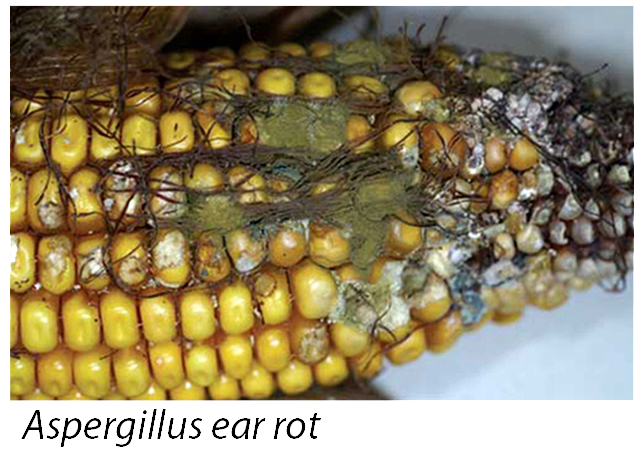
- Can produce a mycotoxin called Aflatoxin
- Aflatoxin is potentially carcinogenic. Use caution when handling.
- More prevalent in hot, dry years.
- Initial infection occurs during late silking.
- Gray-green or olive colored powdery fungal growth starting at the ear tip.
Fusarium ear rot

- Can produce a mycotoxin called Fumonisin
- Can develop under most conditions but favors warm and wet weather.
- Disease enters mainly through ear damage.
- Infected kernels can be scattered on the ear or appear in patches.
- Infected kernels can be tan, brown, or dark purple. Some might display white streaking on the pericarp, usually in a starburst pattern.
- Fungal growth is white to salmon colored.
Diplodia ear rot
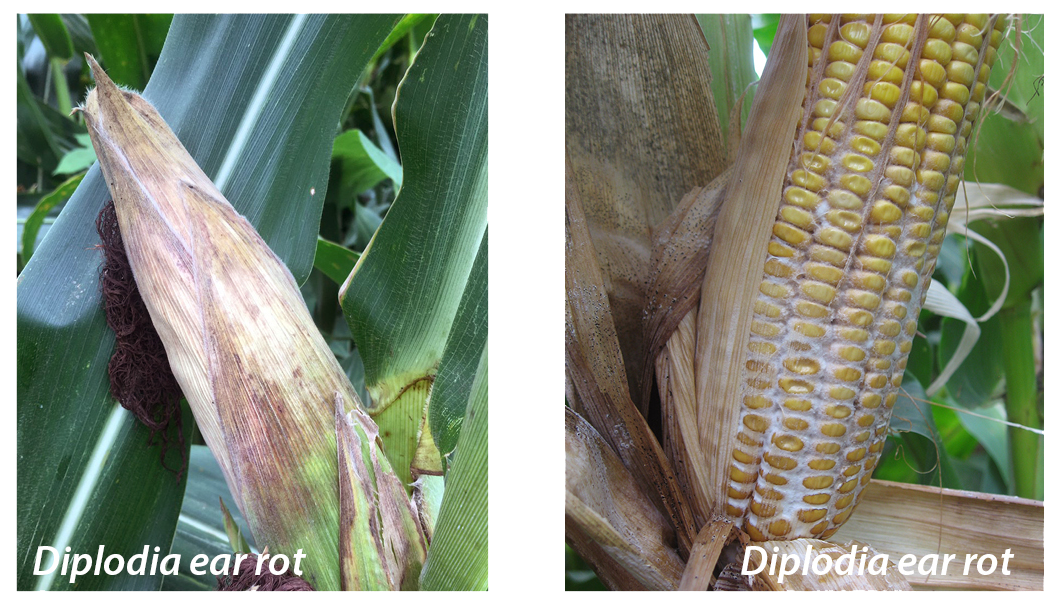
- No mycotoxins have been associated with Diplodia in North America.
- Favors wet weather during silking and grain fill.
- Tight husks and erect ears can promote infection.
- Infection is highly dependent on amount of innoculum on crop residue.
- Early symptoms include a dead ear-leaf and premature brown husks.
- White, cottony fungal growth initially begins at the base of the ear and grows between kernels.
- At advanced stages, the entire ear will be covered by a dense white to grayish fungal growth.
Gibberella ear rot
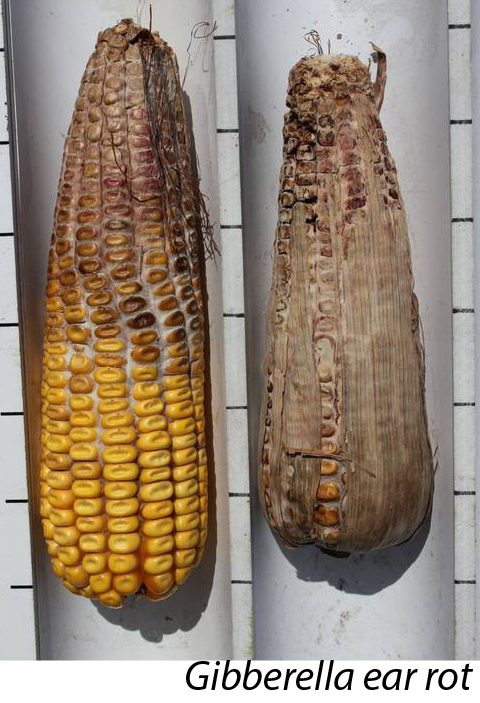
- Can produce two mycotoxins, Deoxynivalenol (vomitoxin) or Zearalenone, which can impact the health of many monogastric animals, especially swine.
- Favors wet weather and cooler temperatures during and after silking.
- Extended rainfall during harvest increases disease severity.
- Initial infection is characterized by the presence of white fungal growth tissue on ear tips.
- Advance infection can cover a large portion of the ear and has a reddish-pink color.
Penicillium ear rot
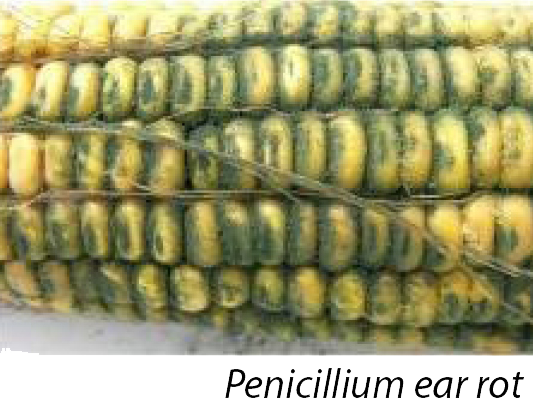
- Some Penicillium species can produce a mycotoxin called ochratoxin.
- Several different species of Penicillium cause ear rot.
- Infection typically occurs during wet and humid conditions prior to harvest, usually following insect or other type of ear damage.
- Can cause “blue eye” by invading the kernel embryo, causing the deep blue coloration.
- Appearance of fungal growth is dark green to bluish-green in between kernels and on the cob.
Trichoderma ear rot
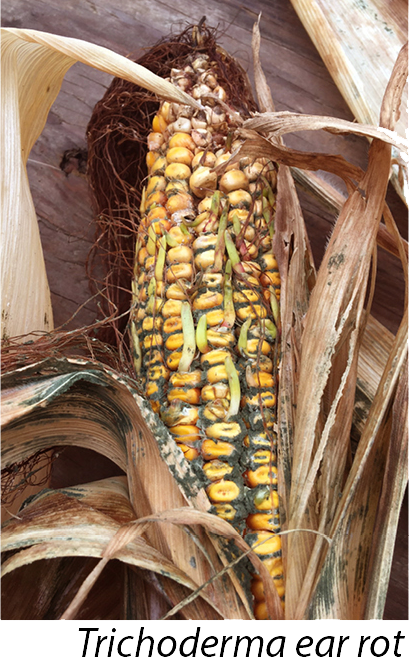
- Some Trichoderma species can produce a mycotoxin called trichothcenes.
- Several different species of Trichoderma can cause ear rot.
- Symptoms include a dark, blue green mold that grows on and between kernels and is visually difficult to distinguish from Penicillium.
- Can cause kernels to prematurely sprout on the ear.
Cladosporium ear rot
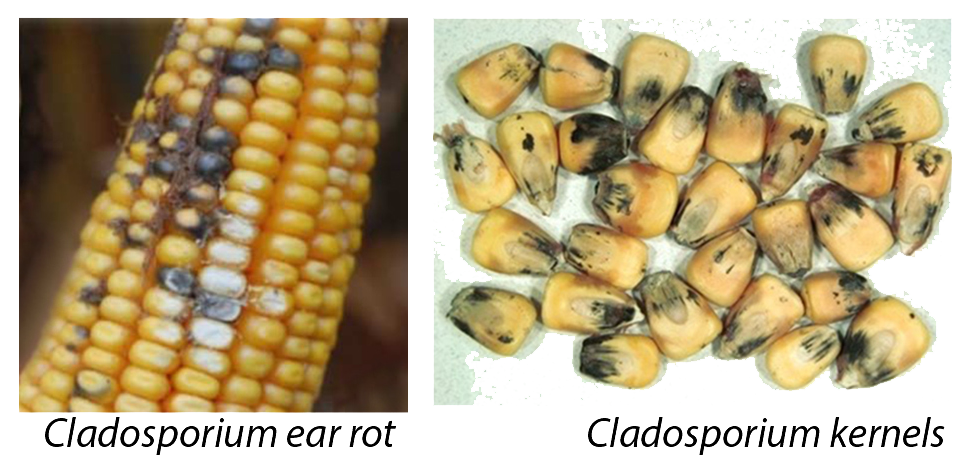
- Is not known to produce mycotoxins.
- Symptoms include infected black colored kernels that are scattered across the ear.
- Infected kernels contain black streaks.
- A dark fuzzy fungus can also grow on and in between kernels.
Conclusion
It’s very important to identify ear molds prior to harvest so that grain can be isolated and doesn’t contaminate other grain in storage. Consult your grain merchandiser to identify marketing opportunities for contaminated grain and limit the amount of time it is kept in storage.
